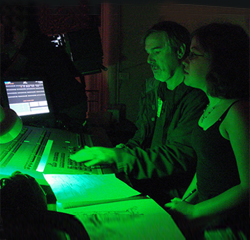
Find Your Looks
My years of experience allow me to take a few shortcuts now, but I am sure I still take these steps subconsciously:
1. Listen to the song; try to pick up a lyric, a musical phrase, or the dynamics that make the general statement of the song.
2. Translate the song into a primary color.
3. Find the high point of the song (it may not be the end).
4. Find the repeating portions of the music, such as the choruses and verses.
This process will probably lead to four or five looks: the opening, the chorus, the verse, the solo spot, and the ending. Changes between verse and chorus may be repeated several times.
Another cue may occur at the turnaround, a musical device found in most pop music that allows the songwriter to repeat a melody by interjecting another musical phrase between similar themes. Are the cues going to be bumps or slow fades? It does not matter what they are. What is important is that they each act as musical punctuation not just fl ashing lights.
After doing this for all of the songs, look at the song order, or set . See if you have the same color patterns for songs that are played back-to-back, and do not hesitate to change the colors to avoid repeating a look in two adjacent songs.
Certainly, a look can be repeated later in the set. If the same color simply must be used, try to change the direction the color comes from; for example, use an amber backlight for the first song but an amber sidelight or an amber follow spot for the next song, with white as a backlight.

Cue Placement
How do you remember where the cues go? Most artists do not follow a script, such as a play or an opera does; however, when lyric sheets are used, the traditional theatre stage manager cue book method could be used (Figure 1).
Some touring lighting designers, including Jeff Ravitz, and almost all of the Las Vegas show designers refer to lyric sheets (Figure 2) for cues, much as a play does. This is a theatrical form not normally used in concert touring but sometimes handy in longer running shows, such as Las Vegas.
Although it is not general practice in Las Vegas for the lighting director to leave after a day or two of a 2-week run, the board operator could follow the lyrics, call the follow spots, and execute the board cues from those notations. I have done this on two occasions when the shows were on long, open-ended runs, and it worked.
The Cue Book
Usually the lighting designer runs the console, except on the biggest tours. If not, the person doing so is traveling with the show and is as familiar with the cues as the designer is. So, if the designer is with the show and knows the music inside out, why bother with a formal cuing method?
There are two good reasons: the possibility of illness or accident and the fact that the designer is most likely working for several clients, and without total recall it is difficult to remember all of the cues for each show. Also, after a few years of touring, an artist can build up an extensive repertoire of songs, not all of which are in the current show. As the tour goes on, old songs may be substituted or new songs tried out.
A lot of mental agility is required to stay on top of all that music. John Denver had over 50 songs that the band rehearsed and could play on any show, and he often substituted without warning. Jeff Ravitz told me that on the most recent Bruce Springsteen tour he had a cue book that was 4 inches thick!
Another way to generate a visual plan for a song is to count out and note each eight bars, just as a choreographer counts out the measures (1 and 2 and 3 and 4 …), and then write the number down and mark any musical changes. Jeff Ravitz, who includes Ringo Starr and Bruce Springsteen among his many clients, says that he cannot possibly keep up with all the cues from all the songs, so he uses the following method.

